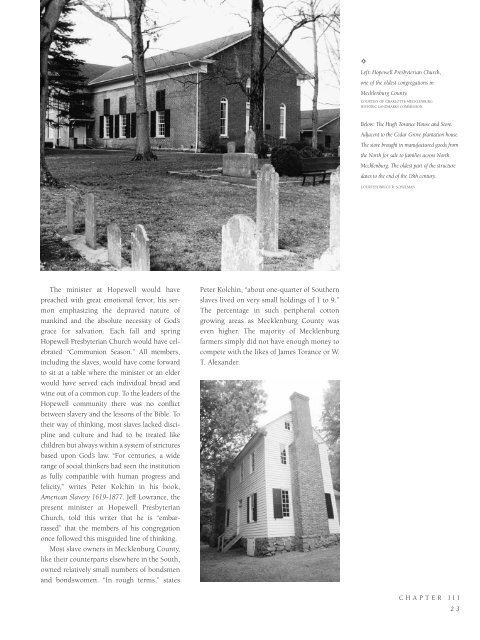Historic Charlotte
An illustrated history of the City of Charlotte and the Mecklenburg County area, paired with the histories of companies, families and organizations that make the region great.
An illustrated history of the City of Charlotte and the Mecklenburg County area, paired with the histories of companies, families and organizations that make the region great.
You also want an ePaper? Increase the reach of your titles
YUMPU automatically turns print PDFs into web optimized ePapers that Google loves.
✧<br />
Left: Hopewell Presbyterian Church,<br />
one of the oldest congregations in<br />
Mecklenburg County.<br />
COURTESY OF CHARLOTTE-MECKLENBURG<br />
HISTORIC LANDMARKS COMMISSION.<br />
Below: The Hugh Torance House and Store.<br />
Adjacent to the Cedar Grove plantation house.<br />
The store brought in manufactured goods from<br />
the North for sale to families across North<br />
Mecklenburg. The oldest part of the structure<br />
dates to the end of the 18th century.<br />
COURTESY BRUCE R. SCHULMAN.<br />
The minister at Hopewell would have<br />
preached with great emotional fervor, his sermon<br />
emphasizing the depraved nature of<br />
mankind and the absolute necessity of God’s<br />
grace for salvation. Each fall and spring<br />
Hopewell Presbyterian Church would have celebrated<br />
“Communion Season.” All members,<br />
including the slaves, would have come forward<br />
to sit at a table where the minister or an elder<br />
would have served each individual bread and<br />
wine out of a common cup. To the leaders of the<br />
Hopewell community there was no conflict<br />
between slavery and the lessons of the Bible. To<br />
their way of thinking, most slaves lacked discipline<br />
and culture and had to be treated like<br />
children but always within a system of strictures<br />
based upon God’s law. “For centuries, a wide<br />
range of social thinkers had seen the institution<br />
as fully compatible with human progress and<br />
felicity,” writes Peter Kolchin in his book,<br />
American Slavery 1619-1877. Jeff Lowrance, the<br />
present minister at Hopewell Presbyterian<br />
Church, told this writer that he is “embarrassed”<br />
that the members of his congregation<br />
once followed this misguided line of thinking.<br />
Most slave owners in Mecklenburg County,<br />
like their counterparts elsewhere in the South,<br />
owned relatively small numbers of bondsmen<br />
and bondswomen. “In rough terms,” states<br />
Peter Kolchin, “about one-quarter of Southern<br />
slaves lived on very small holdings of 1 to 9.”<br />
The percentage in such peripheral cotton<br />
growing areas as Mecklenburg County was<br />
even higher. The majority of Mecklenburg<br />
farmers simply did not have enough money to<br />
compete with the likes of James Torance or W.<br />
T. Alexander.<br />
CHAPTER III<br />
23
















